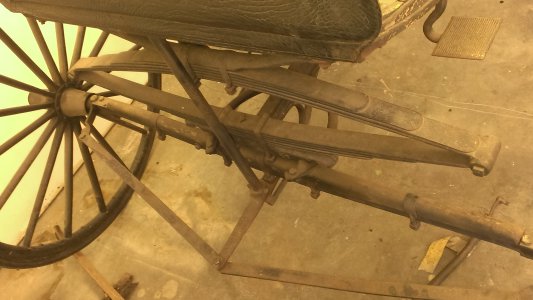Well I have looked a the carriage a little closer. This is definitely a home made job, and not the best quality. So there is little collector value. Its value is to show what people did in a time when cars could not be bought on every corner.
The engine is an aluminum 2 stroke 'drag saw' engine that appears to have been made in Eureka, CA. These were used in the days before chain saws. This thing has exposed points with manually adjustable timing from the drivers seat (used for a throttle as the carburetor is fixed). The coil appears to be a wooden boxed Ford 'buzz coil'. The clutch will have to have a lever installed to engage the chain drive. By the way, the chain has a cotter pin in each link. I have never seen a chain made this way. It does make it easy to separate!
The front axle was locked so it would not turn (as a horse drawn carriage, the whole axle turned pivoting in the center), then a turn buckle was added connected with a bent bolt in the front axle and a piece of chain to the frame. This was presumably to stop wobble but it has the axle slightly nonparallel to the front cross leaf spring suspension.

Then there is the steering! All turning elements are loose, so I will be machining a lot of bushings to tighten things up. I think I may have to build a new pivot for the front wheel axles to allow for caster adjustment. I will have to modify the tie rods to set toe-out.
So all of the steering improvements are based on getting it running. The existing engine will turn over so there is a hope.
I will update this listing as time goes on. All comments, suggestions and information are welcome.



